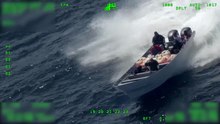Drug trafficking routes

South Americaedit
The neutrality of this section is disputed. (July 2019) (Learn how and when to remove this template message) |
Venezuela has been a path to the United States and Europe for illegal drugs originating in Colombia, through Central America, Mexico and Caribbean countries such as Haiti, the Dominican Republic, and Puerto Rico.citation needed
According to the United Nations, there was an increase of cocaine trafficking through Venezuela since 2002. In 2005, the government of Hugo Chávez severed ties with the United States Drug Enforcement Administration (DEA), accusing its representatives of spying. Following the departure of the DEA from Venezuela and the expansion of DEA's partnership with Colombia in 2005, Venezuela became more attractive to drug traffickers. Between 2008 and 2012, Venezuela's cocaine seizure ranking among other countries declined, going from being ranked fourth in the world for cocaine seizures in 2008 to sixth in the world in 2012.
On 18 November 2016, following what was known as the Narcosobrinos incident, Venezuelan President Nicolás Maduro's two nephews were found guilty of trying to ship drugs into the United States so they could "obtain a large amount of cash to help their family stay in power".
In August 2019, former Dominican players of the MLB, Octavio Dotel and Luis Castillo were suspected of being involved with a massive drug-trafficking ring, alleged to be run by César Emilio Peralta. Authorities claim that they ran narcotics from South America into the United States and Europe.
According to a research conducted by the Abba Eban Institute as part of an initiative called Janus Initiative, the main routes that Hezbollah uses for smuggling drugs are from Colombia, Venezuela and Brazil into West Africa and then transported through northern Africa into Europe. This route serves Hezbollah in making a profit in the cocaine smuggling market to leverage it for terrorist activities.
West Africaedit
Cocaine produced in Colombia and Bolivia increasingly has been shipped via West Africa (especially in Cape Verde, Mali, Benin, Togo, Nigeria, Cameroon, Guinea-Bissau and Ghana). The money is often laundered in countries such as Nigeria, Ghana and Senegal.
According to the Africa Economic Institute, the value of illicit drug smuggling in Guinea-Bissau is almost twice the value of the country's GDP. Police officers are often bribed. A police officer's normal monthly wage of $93 is less than 2% of the value of 1 kilogram (2.2 lb) of cocaine (€7000 or $8750).citation needed The money can also be laundered using real estate. A house is built using illegal funds, and when the house is sold, legal money is earned. When drugs are sent over land, through the Sahara, the drug traders have been forced to cooperate with terrorist organizations, such as Al Qaida in Islamic Maghreb.
Eastern and Southern Africaedit
Heroin is increasingly trafficked from Afghanistan to Europe and America through eastern and southern African countries. This path is known as the “southern route” or “smack track.” Repercussions of this trade include burgeoning heroin use and political corruption among intermediary African nations.
Asiaedit
Drugs in Asia traditionally traveled the southern routes – the main caravan axes of Southeast Asia and Southern China – and include the former opium-producing countries of Thailand, Iran, and Pakistan. After the 1990s, particularly after the Cold War ended, borders were opened and trading and customs agreements were signed so that the routes expanded to include China, Central Asia, and Russia. There are, therefore, diversified drug trafficking routes available today, particularly in the heroin trade and these thrive due to the continuous development of new markets. A large amount of drugs are smuggled into Europe from Asia. The main sources of these drugs are Afghanistan, along with countries that constituted the so-called Golden Crescent. From these producers, drugs are smuggled into the West and Central Asia to its destinations in Europe and the United States. Iran is now the route for smugglers, having been previously a primary trading route, due to its large-scale and costly war against drug trafficking. The Border Police Chief of Iran said that his country "is a strong barrier against the trafficking of illegal drugs to Caucasus, especially the Republic of Azerbaijan." The drugs produced by the Golden Triangle of Myanmar, Laos, and Thailand, on the other hand, pass through the southern routes to feed the Australian, U.S., and Asian markets.
Onlineedit
Drugs are increasingly traded online on the dark web on darknet markets.
Comments
Post a Comment